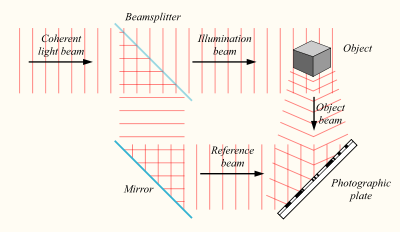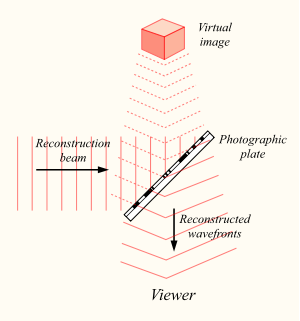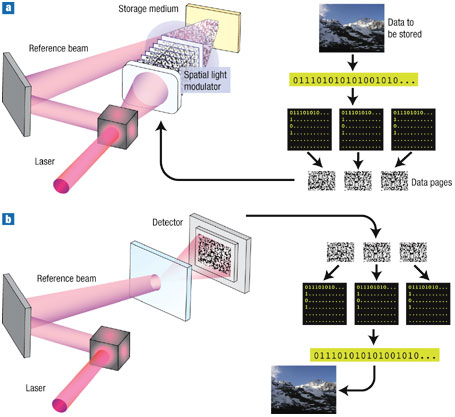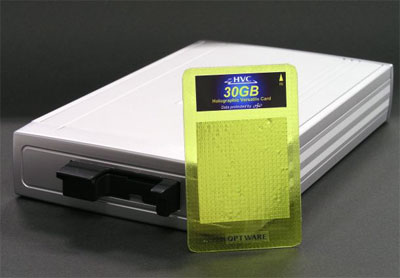History of holography:
- Developed by Denis Gabor in article, “microscopy by reconstructed wavefronts (Gabor, 1949)
- First practical usage of holography done by Yuri Denisyuk and Emmett Leith at University of Michigan in 1962
Holography Mechanics:
- Technique that allows electromagnetic waves from an object to be recorded on a recoding device and later reconstructed by another electromagnetic wave source such that an image of the object can be seen by an imaging system.
- Image produced by the hologram is such that it changes as the position and orientation of the viewing system changes making it seem 3D.
- Recording media – dichromate gelatin, photoresists, photothermoplastics
How to create a hologram:
- Illumination beam from the object of set of objects falls on the recording medium.
- Another light beam known as the reference beam also illuminates the recording medium so that there is interference between both beams (shown below).
- Generates a pattern of varying intensity, which is recorded on the recording medium and is reconstructed later by another light beam (shown below).
A more detailed explanation of how holograms are made is shown in the video below:
Developing Holographic Data Storage:
- Massive amounts of data are stored in the form of holographic images on a relatively small area using lasers.
- Holographic data storage captures data using an optical interference pattern described above within a thick, photosensitive optical medium. Light from a laser beam is divided into dark and light pixels, which are used to create two separate optical patterms in the medium. By adjusting the reference beam angle, wavelength and media position, multiple holograms can be stored on a single volume. The process is shown in the diagram below:
- Azobenzene-containing polymers have been investigated as a medium for holographic discs. When irradiated with linearly polarized light, azobenzene molecules change their orientation to align perpendicular to the light, a property known as macroscopic optical anisotropy. This photo induced change can be used to write information into the material, either bit by bit or by holography. But the recording laser light cannot penetrate right through thick azobenzene films because azobenzene units absorb strongly at this wavelength. Therefore, most studies have been limited to recording in films only a few micrometers thick.
- Scientists have investigated diluting the azobenzene molecules in a polymeric matrix that is transparent at the recording wavelength. The recording light can penetrate through the samples, which can be several hundreds of micrometers thick. but the reduced azobenzene content can result in a decrease in the sensitivity and stability of the recorded holograms. Different approaches based on random copolymers, block copolymers and blends of polymers are being examined to try to fulfill application requirements.
The Technology and Applications of Holographic Data Storage:
- The most obvious application for holographic data storage comes from storing any kind of data on storage media for consumer and business purposes.
- Holographic media can store huge amounts of data because information is encoded in layers throughout the entire disk, not just on a single reflective surface as in today’s optical media.
- How data is read off of a holographic disk: The medium may be a rotating disk containing a polymeric material, or an optically sensitive single crystal. The key to making the holographic data storage system work is the second laser beam which is fired at the crystal to retrieve a page of data. It must match the original reference beam angle exactly. A difference of just a thousandth of a millimeter will result in failure to retrieve the data.
- GE said that micro-holographic players will be backward read-compatible with existing CDs, DVDs and Blu-ray discs.
- Can also be utilized on business servers.
- Can be used to store any form of data.
- Nintendo is planning to use holographic storage for future products.
- If commercialized, will surpass tape and optical storage units in terms of storage size and transfer speed.
- Can store much more information than conventional optical storage devices. Early prototype holographic discs held about 300 GBs, more than 400 times the storage capacity of a CD-ROM.
- Holography promises incredibly high transfer rates–up to 1 Gb per second, 40 times faster than DVD. A holographic system can store up to 60,000 bits in a pulse of light, while a DVD can only transfer one bit of data per light pulse.
- Holographic storage has improved durability over magnetic devices such as tape drives.
- The detector, which is the imaging system for viewing holographic data, is capable of reading data in parallel since multiple holograms can be reconstructed at the same time. It has an incredibly fast data transfer rate: up to 23 MB/s for writing and 13 MB/s for reading.
- Institutes the WORM (write once, read many) data storage model, This means data cannot be overwritten and it can be stored for long periods of time without getting damaged.
- The size of the storage disk will be incredibly small because multiple images can be stored on the same disk. A prototype of a holographic data disk is shown below:
SOURCES:
http://www.computerweekly.com/Articles/2007/08/06/226027/Is-holography-the-future-for-storage.htm
http://www.economist.com/node/1956881?story_id=1956881
http://www.shacknews.com/article/53945/nintendo-exploring-holographic-data-storage
Robinson, T. (2005, June). The race for space. netWorker. 9,2. Retrieved April 28, 2008 from ACM Digital Library.
http://www.inphase-technologies.com/downloads/pdf/technology/HighSpeedHDS500Gbin2.pdf
http://www.sciencedirect.com/science?_ob=ArticleURL&_udi=B6TVF-42RDRS7-D&_user=557743&_coverDate=04%2F01%2F2001&_alid=1725793398&_rdoc=6&_fmt=high&_orig=search&_origin=search&_zone=rslt_list_item&_cdi=5533&_sort=r&_st=13&_docanchor=&view=c&_ct=11830&_acct=C000028458&_version=1&_urlVersion=0&_userid=557743&md5=2e1b8a216746ae188e9e3bd44dea3d6a&searchtype=a
http://sites.google.com/site/fictiontoreality/holographic-data-storage-will-save-internet



